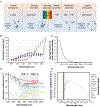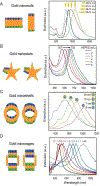Nanomaterial-Enabled Photothermal Heating and Its Use for Cancer Therapy via Localized Hyperthermia
- PMID: 37803412
- PMCID: PMC10922052
- DOI: 10.1002/smll.202305426
Nanomaterial-Enabled Photothermal Heating and Its Use for Cancer Therapy via Localized Hyperthermia
Abstract
Photothermal therapy (PTT), which employs nanoscale transducers delivered into a tumor to locally generate heat upon irradiation with near-infrared light, shows great potential in killing cancer cells through hyperthermia. The efficacy of such a treatment is determined by a number of factors, including the amount, distribution, and dissipation of the generated heat, as well as the type of cancer cell involved. The amount of heat generated is largely controlled by the number of transducers accumulated inside the tumor, the absorption coefficient and photothermal conversion efficiency of the transducer, and the irradiance of the light. The efficacy of treatment depends on the distribution of the transducers in the tumor and the penetration depth of the light. The vascularity and tissue thermal conduction both affect the dissipation of heat and thereby the distribution of temperature. The successful implementation of PTT in the clinic setting critically depends on techniques for real-time monitoring and management of temperature.
Keywords: gold nanoparticles; hyperthermia; photothermal therapy; temperature monitoring; thermotolerance.
© 2023 Wiley-VCH GmbH.
Figures


 ) and dorsal (
) and dorsal ( ) aspect of the forearm. Spectral characteristics are different at the thenar (
) aspect of the forearm. Spectral characteristics are different at the thenar ( ). The penetration depth is only very slowly rising in the UVB and increases steeply in the UVA. Reproduced with permission.[40] Copyright 2008, SCImago. (C) Fraction of total reduced scattering attributed to Rayleigh scattering in skin. Reproduced with permission.[41] Copyright 2005, IOP science. (D) Optical absorption spectra of major endogenous chromophores at typical concentrations occurring in living mammalian tissues. The first (NIR-I) and second (NIR-II) windows, where optical absorption is minimized, are indicated. Reproduced with permission.[42] Copyright 2005, Royal Society of Chemistry. (E) Absorption spectrum of liquid water with the wavelength in the range of 10 nm and 10 m. Reproduced with permission.[47] Copyright 1981, University of Missouri.
). The penetration depth is only very slowly rising in the UVB and increases steeply in the UVA. Reproduced with permission.[40] Copyright 2008, SCImago. (C) Fraction of total reduced scattering attributed to Rayleigh scattering in skin. Reproduced with permission.[41] Copyright 2005, IOP science. (D) Optical absorption spectra of major endogenous chromophores at typical concentrations occurring in living mammalian tissues. The first (NIR-I) and second (NIR-II) windows, where optical absorption is minimized, are indicated. Reproduced with permission.[42] Copyright 2005, Royal Society of Chemistry. (E) Absorption spectrum of liquid water with the wavelength in the range of 10 nm and 10 m. Reproduced with permission.[47] Copyright 1981, University of Missouri.





References
-
- Deng Z, Jiang C, Younis MR, Lei S, He Y, Zheng H, Huang P, Lin J, Chin. Chem. Lett. 2021, 32, 2411–2414.
-
- Jeanjean P, El Hamrani D, Genevois C, Quesson B, Couillaud F, Adv. Mater. Technol. 2022, 7, 2101258.
Publication types
MeSH terms
Grants and funding
LinkOut - more resources
Full Text Sources
Medical

